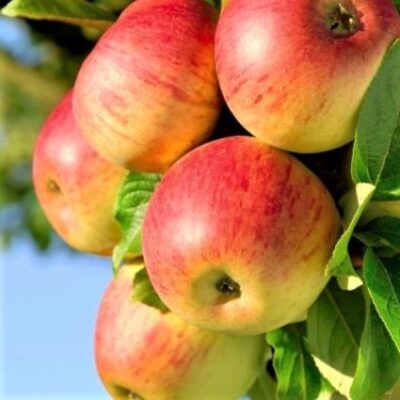Garden Plant: Honeycrisp Apple Tree
Product Description: Honeycrisp Apple Tree

Extended Harvest of Delicious Honeycrisp Apples
- Late Mid-Season
- Extremely Cold Hardy, But Adaptable to Warm Climates
- Self-Fruitful in Many Climates
- Prolonged Harvest
- Bears Fruit at Young Age
- Round Yellow Fruit with a Red Blush
- High Chill 700 – 1000 Hours
Foodies and gardeners, rejoice! Our top-quality Honeycrisp Apple Tree, with a taste that rivals even the great Fuji Apple, can be grown in your home garden. This apple was bred primarily for taste and its ability to grow in extreme cold.
Unlike other commercial apples, the Honeycrisp wasn’t bred to grow, store or ship well. But once people tasted Honeycrisp, the market demand for this delicious apple forced grocery distributors to find a way to get it onto store shelves.
With larger cells than other apples, Honeycrisp literally explode with sweet juice when you bite into it. Beautiful skin is snappy, yet thin – a perfect complement to the crisp flesh – which has just the right balance between sweetness and acidity.
If you have had the pleasure of biting into a Honeycrisp apple bought at your local market, then the thought of that sweet tang and solid crunch is probably making your mouth water right now. But coming out of storage to be shipped to the grocery store does not provide the excellent flavor experience that comes from a fresh picked Honeycrisp from your own backyard.
Imagine how that apple would taste fresh from your own tree. Sweeter, juicier, firmer and just plain better! Plus, you have the added comfort of knowing just what went into (or didn’t go into!) those fresh eating apples before they appear on your family’s table.
A wonderful snack, each Honeycrisp apple has about 80 calories. These powerhouses also have pectic fiber, Vitamin A and C. Grow your own to eat clean.
Congrats to the University of Minnesota for this delightful apple variety, another prizewinning introduction. Recent DNA testing indicates that the parentage includes Keepsake, Golden Delicious and heirloom Duchess of Oldenberg varieties. This is such a successful variety in the more extreme cold climates of Growing Zones 3 and 4. No wonder the state fruit of Minnesota is a Honeycrisp Apple!
This tree grows to an ideal size for an urban or suburban garden and can be kept smaller with pruning. Plant it in well-drained soil, in full sun for optimal growth and plant another variety close by to aid in pollination, if you want the best possible yield.
The Honeycrisp apple is consistently one of the best-selling apples on the market and the price and availability often reflect that.
How to Use Honeycrisp Apples
The Honeycrisp is known for its long hang time on the tree. That means your harvest is extended over a longer period than most apple varieties. The quality just continues to get better with each apple picked. The round yellow fruit produces a red blush as it ripens in September and they don’t immediately drop upon ripening, so you can take your time picking them.
Delicious Honeycrisp apples are yellow with a speckled reddish pink blush. The crisp white flesh is well-balanced between honey sweet and tart and has a wonderful floral aroma.
Of course, as a fresh eating apple, it’s hard to beat a Honeycrisp. Use them in salads, slaws, and dip them in melted caramel for a luscious fall treat. They’ll hold up to pie baking, and you can freeze bags of sliced Honey crisps.
These apples also retain their pigment well and have a relatively long shelf life when they’re stored in cool, dry conditions. Honeycrisp will store well in a cool, dark, dry location for up to 3 months and 6 months in refrigeration.
Pro Plant Tips for Care
Today, home gardeners across the United States can grow Honeycrisp apples in either cold or hot apple growing regions. This includes the upper Midwest, West Coast, Northwest and Northeast.
Honeycrisp performs beautifully in climates with higher summer humidity. It handles extreme cold and high humidity with no problems.
It is adapted to a wide range of soil types and will even tolerate heavy clay if the drainage is good. Once established, most apples require less water. When a layer of mulch is applied to cover the root system, apple trees become quite drought tolerant.
It needs full sun exposure for optimal growth. However, for warmer climates with low summer humidity, plant Honeycrisp trees where they will receive afternoon shade. This will allow the Honeycrisp to be successful in Zone 9.
Hold this tree to any size with annual summer punning. We recommend for home gardeners to maintain their trees to below 10 feet with 7 to 8 feet being the ideal height. Maintain your trees low to assure ease in providing maintenance and harvesting.
The Honeycrisp is self-fruitful and will provide a dependable set year to year, but you can improve your yield by planting with a pollinating partner. Consider planting with varieties ripening at different times to extend your harvest period.
The late mid-season Honeycrisp would partner well with an early Gala, a mid- season McIntosh and a late Granny Smith Apple to extend your apple harvesting season to 6 months.
Thinning is one of the most important maintenance tasks after size control. The Honeycrisp bears young and can overbear. Thin out small fruit to leave a fists space between fruit to lessen the load of the younger trees and to ensure good fruit size on older trees.
The Honeycrisp is disease resistant in most areas. We take pride in delivering the highest quality plants with healthy roots and full, well-established stems and foliage. Honeycrisp Apple trees are always in high demand. Order now before they sell out!
Suggested pollinators are Gala, Granny Smith, Empire, McIntosh and Red Delicious. It is not pollinated by Gravenstein.


